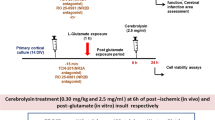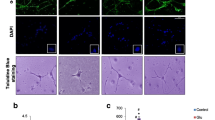Abstract
Glutamate, one of the most important excitatory neurotransmitters, acts as a signal transducer in peripheral tissues and endocrine cells. Excessive glutamate secretion has been shown to cause excitotoxicity and neurodegenerative disease. Cerebrolysin is a mixture of enzymatically treated peptides derived from pig brain including neurotrophic factors, like brain-derived neurotrophic factor (BDNF), glial cell line-derived neurotrophic factor (GDNF), nerve growth factor (NGF), and ciliary neurotrophic factor (CNTF). The present study investigated the protective effects of cerebrolysin on glutamate transporters (EAAT 1, EAAT 2) and cytokines (IL-1β and IL-10) activity in glutamate-mediated neurotoxicity. Primary cortex neuron culture was exposed to glutamate and successively treated with various cerebrolysin concentrations for 24 and 48 h. Our data showed that cerebrolysin primarily protects neurons by decreasing glutamate concentration in the synaptic cleft. In addition, Cerebrolysin can decrease oxidative stress and neuron cell damage by increasing antioxidant activity and decreasing inflammation cytokine levels.








Similar content being viewed by others
Data Availability
The data that support the findings of this study are available from the corresponding author upon reasonable request.
References
Alzoubi KH, Al-Jamal FF, Mahasneh AF (2020) Cerebrolysin prevents sleep deprivation induced memory impairment and oxidative stress. Physiol Behav 217
Atlante A, Calissano P, Bobba A, Giannattasio S, Marra E, Passarella S (2001) Glutamate neurotoxicity, oxidative stress and mitochondria. FEBS Lett 497:1–5
Barker-Haliski M, White HS (2015) Glutamatergic mechanisms associated with seizures and epilepsy. Cold Spring Harb Perspect Med 5
Battaglia G, Bruno V (2018) Metabotropic glutamate receptor involvement in the pathophysiology of amyotrophic lateral sclerosis: new potential drug targets for therapeutic applications. Curr Opin Pharmacol 38:65–71
Buren C, Tue GQ, Raymond LA (2020) Impaired replenishment of cortico-striatal synaptic glutamate in Huntington’s disease mouse model. J Huntington’s Dis 9:149–161
Deletage N, Le Douce J, Callizot N, Godfrin Y, Lemarchant S (2021) SCO-spondin-derived peptide protects neurons from glutamate-induced excitotoxicity. Neuroscience 463:317–336
Fujisawa H, Reis RM, Nakamura M, Colella S, Yonekawa Y, Kleihues P, Ohgaki H (2000) Loss of heterozygosity on chromosome 10 is more extensive in primary (de novo) than in secondary glioblastomas. Lab Invest 80:65–72
Garcia JM, Stillings SA, Leclerc JL, Phillips H, Edwards NJ, Robicsek SA, Hoh BL, Blackburn S, Dore S (2017) Role of interleukin-10 in acute brain injuries. Front Neurol 8:244
Garrido P, Osorio FG, Moran J, Cabello E, Alonso A, Freije JM, Gonzalez C (2015) Loss of GLUT4 induces metabolic reprogramming and impairs viability of breast cancer cells. J Cell Physiol 230:191–198
Gautier HOB, Evans KA, Volbracht K, James R, Sitnikov S, Lundgaard I, James F, Lao-Peregrin C, Reynolds R, Franklin RJM, Karadottir RT (2015) Neuronal activity regulates remyelination via glutamate signalling to oligodendrocyte progenitors. Nat Commun 6
Guan X, Wang Y, Kai G, Zhao S, Huang T, Li Y, Xu Y, Zhang L, Pang T (2019) Cerebrolysin ameliorates focal cerebral ischemia injury through neuroinflammatory inhibition via CREB/PGC-1alpha pathway. Front Pharmacol 10:1245
Gubandru M, Margina D, Tsitsimpikou C, Goutzourelas N, Tsarouhas K, Ilie M, Tsatsakis AM, Kouretas D (2013) Alzheimer’s disease treated patients showed different patterns for oxidative stress and inflammation markers. Food Chem Toxicol 61:209–214
Haddadi N, Lin Y, Simpson AM, Nassif NT, McGowan EM (2017) Dicing and splicing sphingosine kinase and relevance to cancer. Int J Mol Sci 18
Hanani M (2005) Satellite glial cells in sensory ganglia: from form to function. Brain Res Rev 48:457–476
Iovino L, Tremblay ME, Civiero L (2020) Glutamate-induced excitotoxicity in Parkinson’s disease: the role of glial cells. J Pharmacol Sci 144:151–164
Karki P, Hong P, Johnson J Jr, Pajarillo E, Son DS, Aschner M, Lee EY (2018) Arundic acid increases expression and function of astrocytic glutamate transporter EAAT1 via the ERK. Akt NF-kappaB Pathways Mol Neurobiol 55:5031–5046
Lewerenz J, Maher P (2015) Chronic glutamate toxicity in neurodegenerative diseases-what is the evidence? Front Neurosci 9:469
Lu WR, Defilippi J, Braun A (2013) Unleash metformin: reconsideration of the contraindication in patients with renal impairment. Ann Pharmacother 47:1488–1497
Mahmoud S, Gharagozloo M, Simard C, Gris D (2019) Astrocytes maintain glutamate homeostasis in the CNS by controlling the balance between glutamate uptake and release. Cells 8
Makadia HK, Siegel SJ (2011) Poly lactic-co-glycolic acid (PLGA) as biodegradable controlled drug delivery carrier. Polymers (basel) 3:1377–1397
Maragakis NJ, Rothstein JD (2004) Glutamate transporters: animal models to neurologic disease. Neurobiol Dis 15:461–473
Olajide OJ, Gbadamosi IT, Yawson EO, Arogundade T, Lewu FS, Ogunrinola KY, Adigun OO, Bamisi O, Lambe E, Arietarhire LO, Oluyomi OO, Idowu OK, Kareem R, Asogwa NT, Adeniyi PA (2021) Hippocampal degeneration and behavioral impairment during Alzheimer-like pathogenesis involves glutamate excitotoxicity. J Mol Neurosci 71:1205–1220
Parkin GM, Gibbons A, Udawela M, Dean B (2020) Excitatory amino acid transporter (EAAT)1 and EAAT2 mRNA levels are altered in the prefrontal cortex of subjects with schizophrenia. J Psychiatr Res 123:151–158
Patel RAG, McMullen PW (2017) Neuroprotection in the treatment of acute ischemic stroke. Prog Cardiovasc Dis 59:542–548
Pongwecharak J, Tengmeesri N, Malanusorn N, Panthong M, Pawangkapin N (2009) Prescribing metformin in type 2 diabetes with a contraindication: prevalence and outcome. Pharm World Sci 31:481–486
Ramesh M, Ahlawat P, Srinivas NR (2010) Irinotecan and its active metabolite, SN-38: review of bioanalytical methods and recent update from clinical pharmacology perspectives. Biomed Chromatogr 24:104–123
Rattan R, Ali Fehmi R, Munkarah A (2012) Metformin: an emerging new therapeutic option for targeting cancer stem cells and metastasis. J Oncol 2012:928127
Song XR, Gong ZX, Liu KL, Kou JP, Liu BL, Liu K (2020) Baicalin combats glutamate excitotoxicity via protecting glutamine synthetase from ROS-induced 20S proteasomal degradation. Redox Biology 34
Staszewski J, Stȩpień A, Piusińska-Macoch R, Dȩbiec A, Gniadek-Olejniczak K, Frankowska E, Maliborski A, Chadaide Z, Balo D, Król B (2022) Efficacy of cerebrolysin treatment as an add-on therapy to mechanical thrombectomy in patients with acute ischemic stroke due to large vessel occlusion: study protocol for a prospective, open label, single-center study with 12 months of follow-up. Front Neurol 13
Taghizadehghalehjoughi A, Naldan ME (2021) Is ketamine suitable for use in glutamate toxicity conditions?: an in vitro study. J Invest Surg 34:121–128
Taghizadehghalehjoughi A, Sezen S, Hacimuftuoglu A, Gulluce M (2019a) Vincristine combination with Ca(+2) channel blocker increase antitumor effects. Mol Biol Rep 46:2523–2528
Taghizadehghalehjoughi A, Hacimuftuoglu A, Yilmaz A (2019b) Na+ channel blocker enhances metformin effects on neuroblastoma cell line. Med Sci 8:636–640
Ungurianu A, Șeremet O, Grădinaru D, Ionescu-Tîrgoviște C, Margină D, Miulescu RD (2019a) Spectrophotometric versus spectrofluorometric assessment in the study of the relationships between lipid peroxidation and metabolic dysregulation. Chem Biol Drug Des 93:1026–1035
Ungurianu A, Şeremet O, Gagniuc E, Olaru OT, Guţu C, Grǎdinaru D, Ionescu-Tȋrgovişte C, Marginǎ D, Dǎnciulescu-Miulescu R (2019b) Preclinical and clinical results regarding the effects of a plant-based antidiabetic formulation versus well established antidiabetic molecules. Pharmacol Res 150:104522
Vaghef L, Farajdokht F, Erfani M, Majdi A, Sadigh-Eteghad S, Karimi P, Shotorbani SS, Vafaee MS, Mahmoudi J (2019) Cerebrolysin attenuates ethanol-induced spatial memory impairments through inhibition of hippocampal oxidative stress and apoptotic cell death in rats. Alcohol 79:127–135
Valavanidis A, Vlachogianni T, Fiotakis C (2009) 8-Hydroxy-2’-deoxyguanosine (8-OHdG): a critical biomarker of oxidative stress and carcinogenesis. J Environ Sci Health C Environ Carcinog Ecotoxicol Rev 27:120–139
Yeni Y, Cakir Z, Hacimuftuoglu A, Taghizadehghalehjoughi A, Okkay U, Genc S, Yildirim S, Saglam YS, Calina D, Tsatsakis A, Docea AO (2022) A selective histamine H4 receptor antagonist, JNJ7777120, role on glutamate transporter activity in chronic depression. J Pers Med 12
Yilmaz A, Taghi̇zadehghalehjoughi̇ A, Haci̇muftuoglu A, Türkmen A (2021) Investigation of Aloe vera barbadensis Miller leaf extract effects on glutamate and glyphosate induced toxicity: in vitro study. J Anatol Environ Animal Sci 6:376–381
Zanfirescu A, Ungurianu A, Tsatsakis AM, Nitulescu GM, Kouretas D, Veskoukis A, Tsoukalas D, Engin AB, Aschner M, Margina D (2019) A review of the alleged health hazards of monosodium glutamate. Compr Rev Food Sci Food Saf 18:1111–1134
Author information
Authors and Affiliations
Contributions
Conceptualization, Ali Taghizadehghalehjoughi and Kostas Tsarouhas; methodology, Sidika Genc; software, Sukran Gunaydin and Seydanur Avci; formal analysis, Neziha Senem Ari; investigation, Emine Karaca, Ibrahim Gecili, and Ozlem Erol Polat; data curation, Yesim Yeni and Aysegul Yilmaz; writing—original draft preparation, Ahmet Hacimuftuoglu, Aristidis Tsatsakis, and Serkan Yildirim; writing—review and editing, Denisa Margina, David R. Wallace, and Damla Gul Findik; visualization, D.F.; supervision, Ali Taghizadehghalehjoughi and Kostas Tsarouhas; project administration, Muhammed Yasser Mokresh.
Corresponding authors
Ethics declarations
Ethics Approval
This study was conducted at the Medical Experimental Research Center at Ataturk University (Erzurum, Turkey). This study was carried out in strict accordance with the recommendations in the Guide for the Care and Use of Laboratory Animals of the National Institutes of Health. The animal use protocol was reviewed and approved by the Ethical Committee of Ataturk University, study protocol 04–2100268999/30.09.2021.
Consent for Publication
No conflict of interest exists in the submission of this manuscript, and this manuscript is approved by all authors for publication.
Competing Interests
The authors declare no competing interests.
Additional information
Publisher's Note
Springer Nature remains neutral with regard to jurisdictional claims in published maps and institutional affiliations.
Rights and permissions
Springer Nature or its licensor (e.g. a society or other partner) holds exclusive rights to this article under a publishing agreement with the author(s) or other rightsholder(s); author self-archiving of the accepted manuscript version of this article is solely governed by the terms of such publishing agreement and applicable law.
About this article
Cite this article
Avci, S., Gunaydin, S., Ari, N.S. et al. Cerebrolysin Alleviating Effect on Glutamate-Mediated Neuroinflammation Via Glutamate Transporters and Oxidative Stress. J Mol Neurosci 72, 2292–2302 (2022). https://doi.org/10.1007/s12031-022-02078-8
Received:
Accepted:
Published:
Issue Date:
DOI: https://doi.org/10.1007/s12031-022-02078-8




